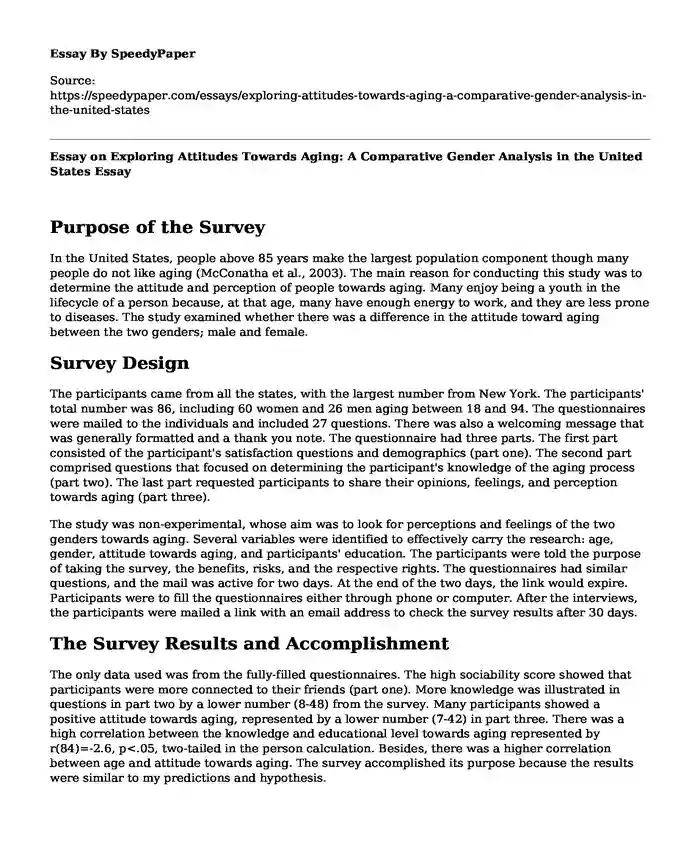Purpose of the Survey
In the United States, people above 85 years make the largest population component though many people do not like aging (McConatha et al., 2003). The main reason for conducting this study was to determine the attitude and perception of people towards aging. Many enjoy being a youth in the lifecycle of a person because, at that age, many have enough energy to work, and they are less prone to diseases. The study examined whether there was a difference in the attitude toward aging between the two genders; male and female.
Survey Design
The participants came from all the states, with the largest number from New York. The participants' total number was 86, including 60 women and 26 men aging between 18 and 94. The questionnaires were mailed to the individuals and included 27 questions. There was also a welcoming message that was generally formatted and a thank you note. The questionnaire had three parts. The first part consisted of the participant's satisfaction questions and demographics (part one). The second part comprised questions that focused on determining the participant's knowledge of the aging process (part two). The last part requested participants to share their opinions, feelings, and perception towards aging (part three).
The study was non-experimental, whose aim was to look for perceptions and feelings of the two genders towards aging. Several variables were identified to effectively carry the research: age, gender, attitude towards aging, and participants' education. The participants were told the purpose of taking the survey, the benefits, risks, and the respective rights. The questionnaires had similar questions, and the mail was active for two days. At the end of the two days, the link would expire. Participants were to fill the questionnaires either through phone or computer. After the interviews, the participants were mailed a link with an email address to check the survey results after 30 days.
The Survey Results and Accomplishment
The only data used was from the fully-filled questionnaires. The high sociability score showed that participants were more connected to their friends (part one). More knowledge was illustrated in questions in part two by a lower number (8-48) from the survey. Many participants showed a positive attitude towards aging, represented by a lower number (7-42) in part three. There was a high correlation between the knowledge and educational level towards aging represented by r(84)=-2.6, p<.05, two-tailed in the person calculation. Besides, there was a higher correlation between age and attitude towards aging. The survey accomplished its purpose because the results were similar to my predictions and hypothesis.
What I Would Do Differently
However, if I did the study, I would ensure gender balance and interpersonal interviews. I would also ensure that the questionnaires were filled in a confined place to avoid other people filling the questionnaires on behalf of the participants.
Discussion, Limitations and Recommendations
The findings showed that older people have a positive attitude towards aging, while young people have a negative attitude towards aging, as I had predicted. Besides, my predictions and findings showed that people with higher knowledge have a positive attitude towards aging. Contrary to my hypothesis that men have a negative attitude towards aging than women, the survey indicated that both genders have a similar perception towards aging.
There was no gender balance among the participants; hence, both genders' perceptions of aging were not accurately determined. In the future, I recommend a gender balance of the participants, and the survey also focuses on the risk factors tied to aging.
Effectiveness of the Questionnaire
According to Babbie (1989), the survey is effective if the questionnaire is designed well with quality questions. The questionnaire should also have to pose clear response options. The survey was effective because it had both closed-ended questions and fewer open-ended questions. The duration of filling the questionnaire after opening the link was 20 minutes and this is recommended by Babbie.
References
Babbie, E. R. (1998). The practice of social research. International Thomson Publishing Services.
McConatha, J. T., Schnell, F., Volkwein, K., Riley, L., & Leach, E. (2003). Attitudes toward aging: A comparative analysis of young adults from the United States and Germany. The International Journal of Aging and Human Development, 57(3), 203-215.
Cite this page
Essay on Exploring Attitudes Towards Aging: A Comparative Gender Analysis in the United States. (2023, Dec 15). Retrieved from https://speedypaper.net/essays/exploring-attitudes-towards-aging-a-comparative-gender-analysis-in-the-united-states
Request Removal
If you are the original author of this essay and no longer wish to have it published on the SpeedyPaper website, please click below to request its removal:
- Free Essay About Transgender in the Contemporary American Society
- Free Essay on Standardizing American Political Advertisements
- I Am From - Personal Essay Example
- Free Essay. How the Convict Labor System Was Worse Than Slavery
- Paper Example - Relationship between Law and Order in a Democratic, Free Society
- Essay Example: Key Differences Between Domestic, International, and Global Markets
- Team Reasoning: Navigating Dilemmas in Politics and Business - An Analytical Essay
Popular categories





